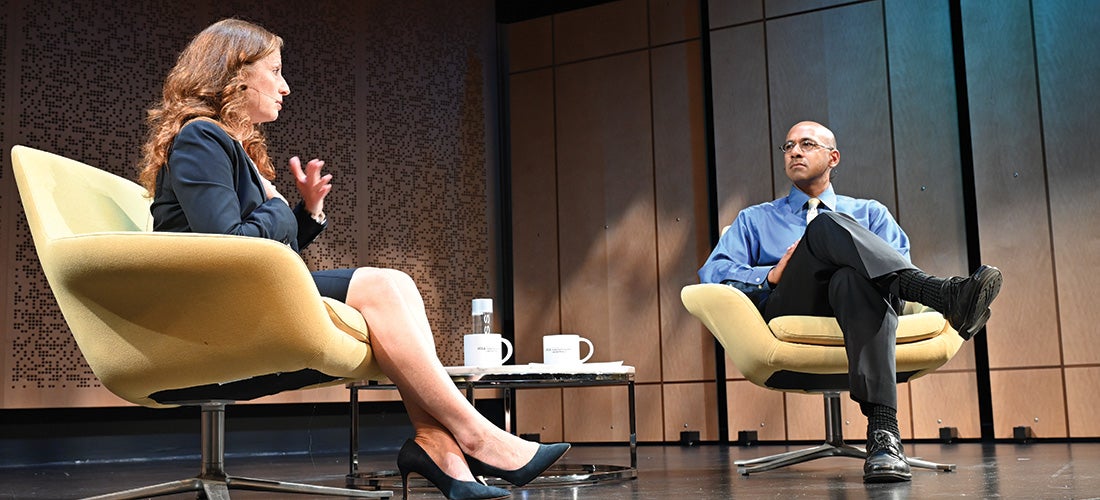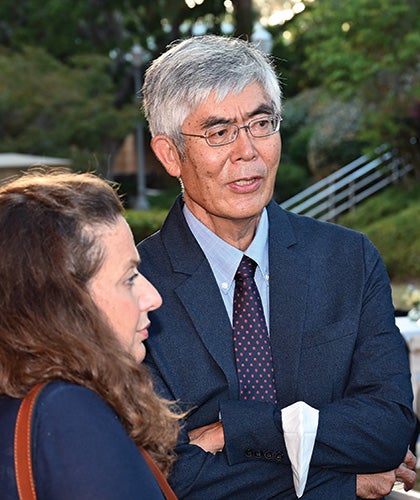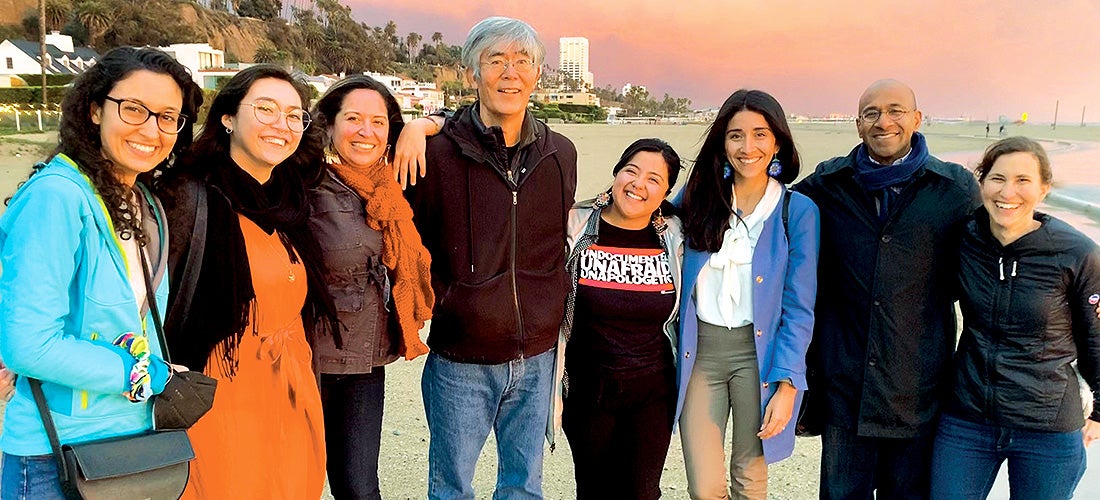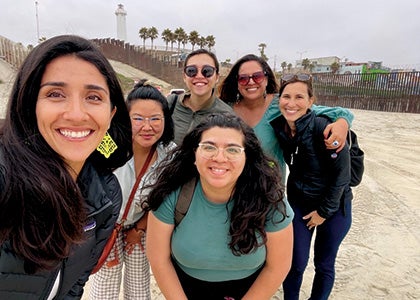From sushi to SCOTUS, visionary team leads new immigration law center
So a legal scholar and a litigator walk into a sushi restaurant

Despite its resemblance to the opening line in an amateur night comedy set at the bar association, this scenario actually marked a turning point in a collaboration that led to a groundbreaking immigration law center at UCLA Law. (We’ll get back to sushi shortly.)
The Center for Immigration Law and Policy (CILP) was founded in 2020 thanks to a $5 million gift from alumna and UCLA Foundation chair Alicia Miñana de Lovelace and her husband, Rob Lovelace. This gift was followed by an additional $5 million gift from an anonymous donor.
Over the past year, CILP has grown to a team of eight, and in its short history, the center has undertaken initiatives and projects in a manner unlike anything else in academia, the think-tank world, or nonprofit organizations. It has conducted novel research on the role of state and local governments, entered into settlement negotiations in a class action that wound its way to the United States Supreme Court, and engaged in impact litigation at all levels of the U.S. judiciary.
But to understand the ambitious docket of the growing center, it’s important to look back decades to the time an early leader in the field of immigration law began persistently asking, “What’s next?”
The Origin of CILP

When Hiroshi Motomura, the Susan Westerberg Prager Distinguished Professor of Law and faculty co-director of CILP, began his academic career in immigration law, he recalls that it was an esoteric, niche topic with no dedicated textbook.
“I’ve been one of the oldest people in this field for 30 years,” Motomura says, laughing. “I feel that I was like these people who say they started the internet or something.”
Motomura helped take the relatively limited field into the mainstream in part by co-authoring one of the main immigration law textbooks used in law schools today, as well as authoring two other influential books that have shaped thinking on immigration law in and out of law schools.
“Hiroshi wrote the books…literally,” says Gabriela Domenzain, CILP’s director of communications.
In 2008, Motomura joined the full-time faculty at UCLA Law. He was finishing his second book and had begun thinking strategically about the future of the immigration law program at UCLA. “I realized it’s not just about me writing a book or two,” he recalls. “There needed to be more engagement with immigration law and policy that generated innovative thinking, applied that thinking to cutting-edge issues, and made these efforts integral to legal education at UCLA.”
One of the young lawyers influenced by Motomura’s scholarship was Ahilan Arulanantham, who is now a UCLA Law professor of practice and faculty co-director of CILP with Motomura. He has argued multiple immigration cases before the Supreme Court and various courts of appeals and is recognized widely as one of the nation’s most influential immigration law litigators.
The son of Sri Lankan Tamil immigrants, Arulanantham was in grade school when the civil war in Sri Lanka displaced many people in his extended family. For several years, up to 15 family members and, later, others from the Tamil refugee community, stayed with his parents. As he recalls, “I grew up with displaced people.”
When he was a student at Yale Law School in the late 1990s, Arulanantham read Motomura’s work. Later, he recalls, as a clerk in the 9th Circuit Court of Appeals, Motomura’s scholarship was very influential in a prominent immigration case he worked on. The eventual Supreme Court decision in that case, Zadvydas v. Davis, held that the federal immigration statute does not allow indefinite detention of an immigrant under a pending removal order because that reading would raise serious doubts about the statute’s constitutionality.
Around the time Motomura started at UCLA Law, he met Arulanantham, who had begun working at the ACLU of Southern California in 2004. The two were organizers of and attended an informal occasional gathering of Los Angeles–area immigration lawyers that became known as the Usual Suspects Dinner.
Many of the other Usual Suspects were, like Arulanantham, from nonprofit legal organizations. Arulanantham recalls that Motomura was among the first members of the group from the academic side. “He builds community,” he says of Motomura. “He helped to cement the group and also tie academics into it.”
At Arulanantham’s request, Motomura began giving a one-day crash course on immigration law for summer interns at the ACLU and other area nonprofits. Motomura has continued to teach this seminar every summer.
This is where we return to the sushi restaurant.
After the summer seminars, Arulanantham would take Motomura to lunch “as sort of informal compensation.” Over sushi at a restaurant in Little Tokyo in Los Angeles, they talked about what was going well in immigration law and what could be better.
Eventually, the scholar and the practitioner began discussing a big idea.
The Evolution of CILP
In 2014, Motomura had finished his second book and was considering the next steps for the UCLA Law immigration program. The school’s immigration clinic had operated up to that point in collaboration with an outside nonprofit organization. By 2017, funding was available for two clinics that would be operated in- house: one to focus on policy issues and one to focus on direct legal services for immigrants.
Motomura started thinking even bigger: “How do you turn this from the two clinics, faculty scholarship on immigration, plus a lot of student interest and an array of courses… How do you turn it all into a center that creates synergies that amount to something more than the sum of its parts? What does that mean?”
Motomura says it was important to combine scholarly work with a practice perspective. Over time, his annual conversations with Arulanantham became more frequent and turned to the subject of what a center for immigration law and policy might look like at UCLA.
Arulanantham had considered helping to launch an immigration center at UCLA Law for a few years, but during the Trump administration it hadn’t seemed like the time to step away from litigation.
The moment finally came in 2020: The law school received the $5 million gift from Miñana de Lovelace, herself a child of immigrants. And after the presidential election, Arulanantham decided the time was right to make the transition to academia.

The Direction of CILP
According to Domenzain, it’s a “magical moment” for immigration law at UCLA.
CILP has been building staff and programs since receiving its second $5 million gift, in late 2020. It has established a group of primary initiatives—“buckets”—that consolidate its mission and guide the projects it will take on.
The buckets comprise substantive work on state and local government, federal reform, systemic racism and transnational migration.
State and local government
Immigration is often seen as a subject for the federal government. But after more than three decades of federal inaction, CILP is looking at the ways state and local governments can tackle the problems involved.
At the federal level, says Arulanantham, “everything gets sort of sucked into the partisan vortex and then becomes impossible to develop rational policy around. And once it becomes a pawn on the chessboard of the red-blue death match…if anybody does anything in that one area, all the other people have to oppose it. I see one way out of that as devolving power out of the center, giving space for more state and local policy setting.”
For example, CILP’s research recently uncovered that state institutions are not bound by the federal law that prohibits hiring undocumented immigrants. That research has served as the foundation for a campaign headed by undocumented UCLA students that asks the University of California to allow for the hiring of undocumented immigrants. “We have a community of people on our campus who are undocumented and need to work,” says Astghik Hairapetian, a CILP law fellow, whose research with Arulanantham was central to the campaign, “and we think that there is a strong legal argument that they should be able to work within the university.” Arulanantham calls the work groundbreaking, noting that “we’re starting right here at home.”
Federal reform
Although it can be difficult for the federal government to come to a consensus on immigration, CILP is committed to being a leading voice on such issues nationally. “We’re national players,” says Talia Inlender, CILP’s deputy director. “We have the benefit of being able to influence both new and innovative projects happening at the state and local level while also being involved in trying to seed whatever change is possible at the federal level.”
According to Inlender, these issues include the rights of children in removal proceedings, prolonged detention during and after removal proceedings, and the Temporary Protected Status program, which provides immigration status and work permits for nationals of countries where current conditions make it dangerous or difficult for them to return. For example, Arulanantham is currently representing plaintiffs in Ramos v. Mayorkas, a case challenging the government’s attempt to strip lawful immigration status from nearly half a million immigrants with Temporary Protected Status, the majority of whom have lived in the United States for more than 20 years.
Systemic racism
“I’ve come to see that immigration law as a whole, for most of the country’s history, was basically a set of laws designed to curate the racial composition of the United States,” says Arulanantham. This pillar of CILP’s docket is grounded in research that shows that many immigration laws throughout the United States gave legal expression to racist sentiment, particularly anti-Mexican and anti-Asian.
Motomura says CILP recently completed a report funded by an appropriation in the California State budget at the behest of the legislature’s Asian American & Pacific Islander Caucus. It found that drug laws and laws regarding so-called crimes of “moral turpitude,” conviction of which affects immigration status, were originally based on anti-Asian racism. CILP has also filed amicus briefs before the Supreme Court and other federal courts based on its research on such laws.
Transnational migration
CILP has begun working across borders to help develop a new set of best practices for regional migration frameworks. According to Inlender, many of today’s laws on refugees and asylum “came out of the ruins of World War II” and do not adequately address modern concerns such as climate migration. CILP is beginning to organize a conference with several universities in Mexico City to discuss the role of Mexico and similarly situated countries that are often transit points for forced migrants from elsewhere.
It was crucial for CILP to have a presence near the U.S.-Mexican border to have direct contact with people affected by immigration laws, and work done by Monika Y. Langarica, a CILP staff attorney, has been essential to the center’s transnational engagement.
Langarica was “born and raised in the borderlands” in Southern California. Today she works in the border communities near where she grew up. Her role with CILP ranges broadly from direct legal representation to research and impact litigation.
“On some days,” says Langarica, “I’m knee-deep in legal research and writing. Other days, I’m in an ICE [U.S. Immigration and Customs Enforcement] detention center in Imperial, California, or in Tijuana, meeting with clients.” Langarica represents clients in immigration, federal district, and federal appellate courts and has filed amicus briefs before the Supreme Court.
In all these so-called buckets, CILP brings its unique approach, focusing on nontraditional avenues of advocacy and cross- disciplinary work. To support that approach, the first person Motomura and Arulanantham hired onto the center’s staff wasn’t an immigration attorney but a strategic communications professional—Gabriela Domenzain. She has worked extensively as a journalist, served in strategic roles on two presidential campaigns, and led many political and advocacy campaigns. Throughout her career, Domenzain has sought to elevate and center the voices of those directly affected by U.S. immigration policies.

“Whether in politics, media or advocacy,” says Domenzain, “I couldn’t believe how many conversations on the issue of immigration were occurring without considering immigrant voices, much less centering them, and I’ve spent my career trying to change that.” Domenzain had long been aware of Arulanantham’s work, and when she heard of the opening with CILP, she jumped at the opportunity.
“We consider public awareness and engagement as central to our work and its impact,” Domenzain says. “In other words, media isn’t a tactic, it’s a strategy.” Her previous work in political communications and running media campaigns for litigants in high- profile cases led to her realization that it can be a challenge to amplify the voices of individuals without simply using them to achieve an end. That’s why she is excited about CILP’s holistic and overarching approach to immigration issues. “In the end, and with deep and personal involvement, the people we represent become leaders who challenge immigration policies not only inside the courts but outside as well.”
The Student Experience
“Come talk to us,” says Inlender, inviting any student with an interest in immigration issues to engage with CILP. “There are so many ways to be an immigration lawyer.” She notes that CILP faculty and staff can help students see the many ways in which they can direct their interest, including opportunities to participate in cutting-edge research, clinical programs, an expanded array of courses and cross-disciplinary work.
Research opportunities
As a student, Astghik Hairapetian was interested in immigration issues but had no experience in the field. That changed when she became Motomura’s research assistant. Hairapetian is interested in the intersection of immigration law, human rights law and international law. Her research with Motomura focused on migration laws in migrants’ destination countries and countries of origin. Today she is on CILP’s staff as a law fellow.
The center will continue to provide law students with such opportunities to be involved in research on important immigration issues with leaders in the field.
Clinics
The two clinics affiliated with CILP—the Immigrants’ Rights Policy Clinic and the Immigrant Family Legal Clinic—offer complementary perspectives. Both were established before the center was created and are now benefiting from the breadth of talent it has brought to the law school. Bringing the groups under one umbrella is part of Motomura’s longstanding vision of institutional cohesion.

Inlender, who co-teaches the Immigrants’ Rights Policy Clinic alongside Motomura, says her own clinic experience when she was in law school shaped her career path. The granddaughter of Polish Jewish refugees who survived a Siberian labor camp, Inlender grew up with a love of cultures and languages. In law school, she represented a women’s rights activist from the Democratic Republic of the Congo in an asylum proceeding, which Inlender’s client won. Another woman who had been in the same prison in the Congo was at the hearing.
“When [my client] was granted asylum,” Inlender says, “they started singing this song that they’d sung across these barbed wires to one another when they were in prison.” At that moment, Inlender says she knew what she wanted to do with her life. She hopes that clinical experience at UCLA Law can be similarly transformative for students.
The Immigrants’ Rights Policy Clinic generally does not represent clients directly, but it takes on projects that address overarching issues within immigration law and policy. For example, the clinic is spearheading an advocacy campaign in connection with settlement talks arising from the landmark immigrants’ rights class action case Jennings v. Rodriguez.
Represented by Arulanantham, the class members—all of whom were imprisoned by ICE for six months or more without the opportunity to ask a judge for release on bond—argued that they were entitled to periodic bond hearings under the immigration statute and the Constitution. The class won before the district and appellate courts on statutory grounds, after which the government sought Supreme Court review. Arulanantham represented his clients in the Supreme Court, which held that the immigration statute did not entitle class members to periodic bond hearings; the court remanded the case to the lower courts to address the constitutional questions. The Biden administration has begun settlement talks with the class in hopes of establishing a system more clearly defining the scope of ICE authority in such cases.
In the spring semester of 2022, policy clinic students developed materials for a public awareness campaign on issues addressed by the case. “The idea,” says Inlender, “is to use the talks as an opportunity to educate the public on the realities and impacts of ICE detention. The students worked directly with Alex Rodriguez, the lead plaintiff in the litigation, to develop campaign materials including a draft op-ed, talking points, and social media messaging.”
Complementing the project-based advocacy of the policy clinic, the Immigrant Family Legal Clinic—headed by its director, Nina Rabin, and informally referred to as ImmFam—offers law students the opportunity to acquire experience with direct legal services in a unique school-based legal clinic. In an innovative partnership with the Los Angeles Unified School District, ImmFam is located at the Robert F. Kennedy Community Schools, six public schools housed on a single campus serving 4,000 students in the Koreatown/Pico Union neighborhoods. From its office on that campus, ImmFam provides direct legal representation to immigrant students and their families and has succeeded in starting many RFK students on a path to citizenship. ImmFam also provides advice, counseling and outreach on a variety of other legal issues affecting immigrant families in the school community, including housing and workers’ rights.
Students in the two clinics also have opportunities for crossover work, exemplified recently by a report undertaken by the policy clinic on a new expedited immigration docket after ImmFam students noticed a trend of recently arrived immigrant parents coming in for consultations about rapidly approaching hearing dates.
Cross-disciplinary work
CILP often reaches out within the law school and the university at large to study issues that intersect with immigration; students are able to encounter these types of issues in their courses and clinical work. For example, the Criminal Law Clinic, headed by Professor Ingrid Eagly, a leading scholar on the intersection of criminal justice and immigration laws, frequently works with clients who need to navigate both systems, and she produces research that informs CILP’s work. In addition, Domenzain teaches clinic students how to work with the media in support of advocacy efforts.
Finding Common Ground
As politically charged as immigration has been in recent years, CILP is aiming to be a place where challenging questions can be explored with civility.
“Part of what we’re trying to do at the center,” says Inlender, “is create spaces for hard conversations because clearly, whether you’re left, right or center, I think everyone can agree that there are deep problems with our immigration system [and] the way that we approach immigration. We need change. The contours of what that change looks like might be different from different perspectives, but a piece of what the center is setting out to do is to have those hard conversations.”
Domenzain says that the center tries to create a “both/and” framework for discussing immigration issues. “We want to talk to people who have different opinions,” she says, “and always be inclusive of impacted individuals’ voices.” In an example of this, she says, CILP hosted a conversation with two leading experts on issues at the intersection of immigration law and criminal law along with Alex Rodriguez, the lead plaintiff in the Jennings v. Rodriguez litigation, who had been imprisoned by ICE for more than three and a half years.
“The movement can talk abstractly and take a position against the expanded use of alternatives to detention, for example,” says Domenzain, “but there is nothing like hearing Alex, who was subjected to four years of home confinement after his incarceration, talk about the impact his freedom had on him, even with an ankle monitor and constant surveillance.”
CILP hopes to promote such conversations between those inside the immigrants’ rights movement and outside of it.
The Future of CILP
For career litigator Arulanantham, the transition to co-leading CILP has been an adjustment. In contrast to managing high- profile immigration litigation—which he continues to do—he notes that the goal of the entire immigration discussion taking place at CILP “is not just to win five votes.” He enjoys the unique opportunity to think more broadly about immigration law in the United States and beyond.
For Motomura, CILP is the culmination of decades of leadership in the field of immigration law. Says Domenzain, “All the work Hiroshi has been doing all these years is having renewed impact.”
Ultimately, says Motomura, “I want the center to be a big part of what I contribute to the school.”
For both the scholar and the litigator, the past couple of years working to build CILP have only marked a beginning. As the center continues to grow, one thing is clear. “If you’re interested in immigration law and policy,” Domenzain says, “UCLA is the place to be.”
First published in UCLA Law's fall 2022 magazine.